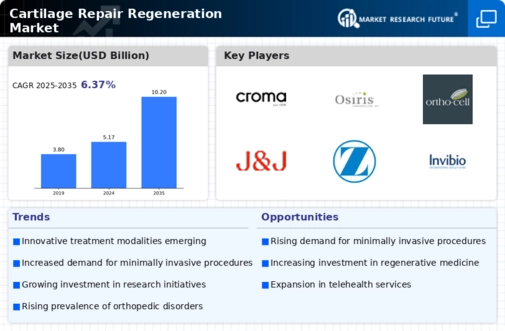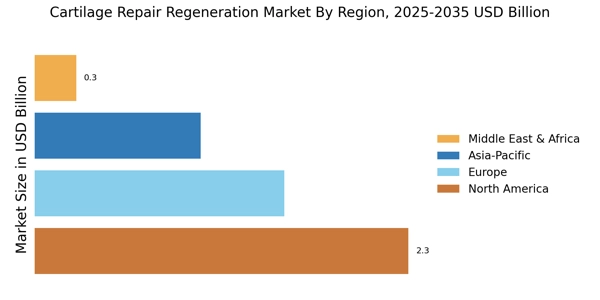Rising Incidence of Osteoarthritis
The increasing prevalence of osteoarthritis is a primary driver for the Cartilage Repair Regeneration Market. As populations age, the incidence of osteoarthritis rises, leading to a greater demand for effective cartilage repair solutions. According to recent estimates, osteoarthritis affects millions worldwide, significantly impacting mobility and quality of life. This condition often necessitates surgical interventions, thereby propelling the market for cartilage repair products. The growing awareness of treatment options, including regenerative therapies, is likely to further stimulate market growth. As healthcare providers seek innovative solutions to address this widespread issue, the Cartilage Repair Regeneration Market is poised for expansion, with a focus on developing advanced therapies that can restore cartilage function and alleviate pain.
Rising Awareness of Regenerative Medicine
The growing awareness of regenerative medicine is significantly influencing the Cartilage Repair Regeneration Market. As patients become more informed about their treatment options, there is an increasing demand for advanced therapies that promote healing and regeneration. Educational initiatives and outreach programs are helping to disseminate information about the benefits of cartilage repair techniques, including stem cell therapies and tissue engineering. This heightened awareness is likely to lead to greater patient engagement in treatment decisions, driving demand for innovative solutions. Furthermore, as healthcare providers recognize the potential of regenerative medicine, they are more inclined to adopt these therapies in clinical practice. Consequently, the Cartilage Repair Regeneration Market is expected to experience robust growth as awareness continues to rise.
Technological Innovations in Cartilage Repair
Technological advancements play a crucial role in shaping the Cartilage Repair Regeneration Market. Innovations such as 3D bioprinting, stem cell therapy, and tissue engineering are revolutionizing the way cartilage injuries are treated. These technologies enable the development of more effective and personalized treatment options, which are increasingly sought after by patients and healthcare providers alike. For instance, the integration of biomaterials in cartilage repair procedures has shown promising results in enhancing healing and regeneration. As these technologies continue to evolve, they are expected to drive market growth by offering new solutions that improve patient outcomes and reduce recovery times. The Cartilage Repair Regeneration Market is likely to witness a surge in demand for these cutting-edge therapies as they become more accessible and widely adopted.
Growing Investment in Research and Development
Investment in research and development is a significant driver for the Cartilage Repair Regeneration Market. Increased funding from both public and private sectors is facilitating the exploration of novel therapies and treatment modalities. This financial support is essential for advancing scientific knowledge and developing innovative products that address unmet medical needs in cartilage repair. Recent data indicates that R&D expenditures in the field of regenerative medicine have seen substantial growth, reflecting a commitment to improving treatment options for cartilage injuries. As more companies enter the market with new technologies and therapies, competition is likely to intensify, further propelling the Cartilage Repair Regeneration Market. This trend suggests a promising future for the development of effective and safe cartilage repair solutions.
Aging Population and Increased Sports Activities
The aging population, coupled with a rise in sports and physical activities, is a key driver for the Cartilage Repair Regeneration Market. As individuals engage in more active lifestyles, the incidence of cartilage injuries is likely to increase, necessitating effective repair solutions. Additionally, the aging demographic is more susceptible to degenerative joint diseases, further amplifying the demand for cartilage repair therapies. Recent statistics indicate that a significant portion of the population participates in recreational sports, which can lead to injuries requiring cartilage repair. This dual trend of an aging population and increased sports participation suggests a growing market for cartilage repair products. The Cartilage Repair Regeneration Market is thus positioned to benefit from these demographic shifts, as the need for effective treatment options becomes more pronounced.


















Leave a Comment